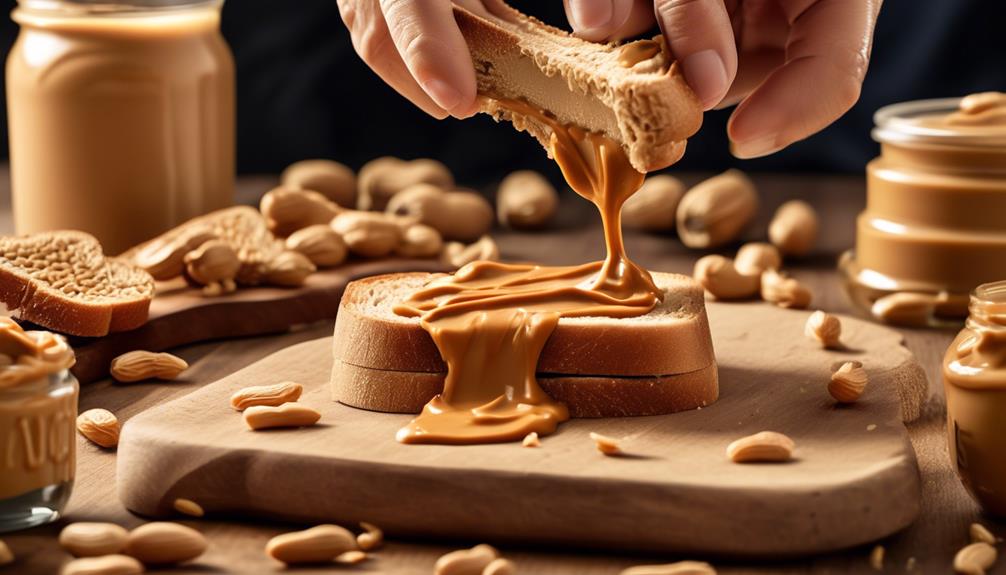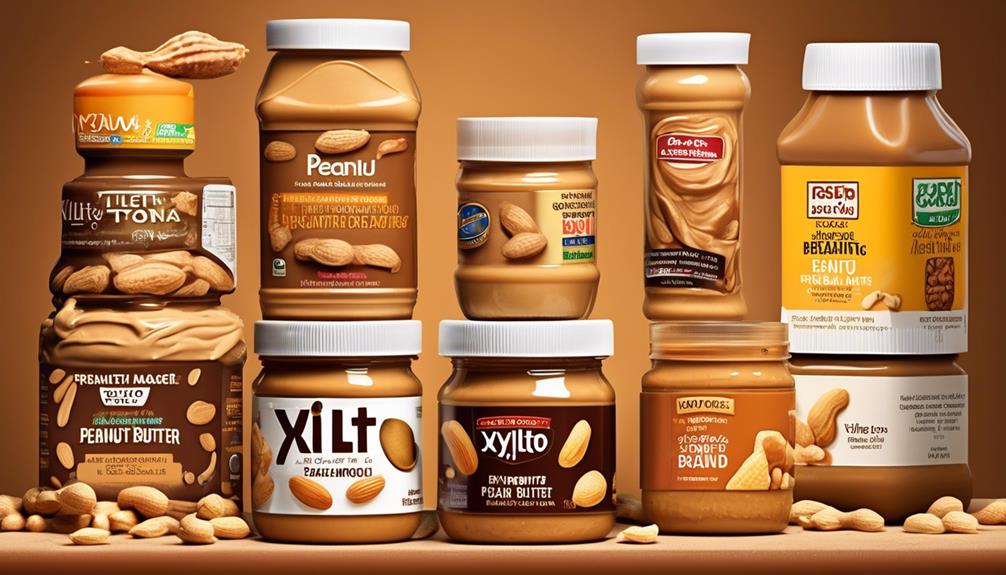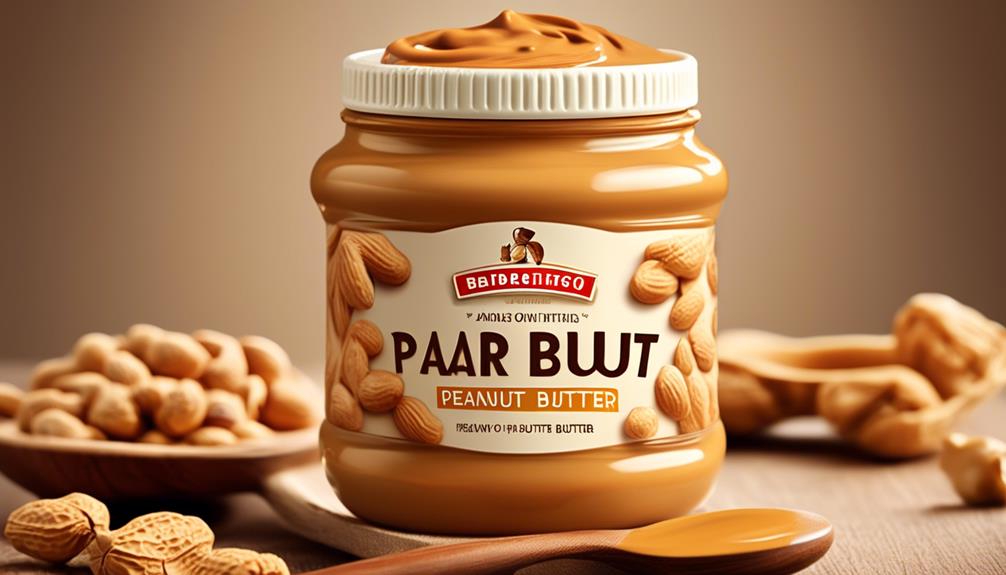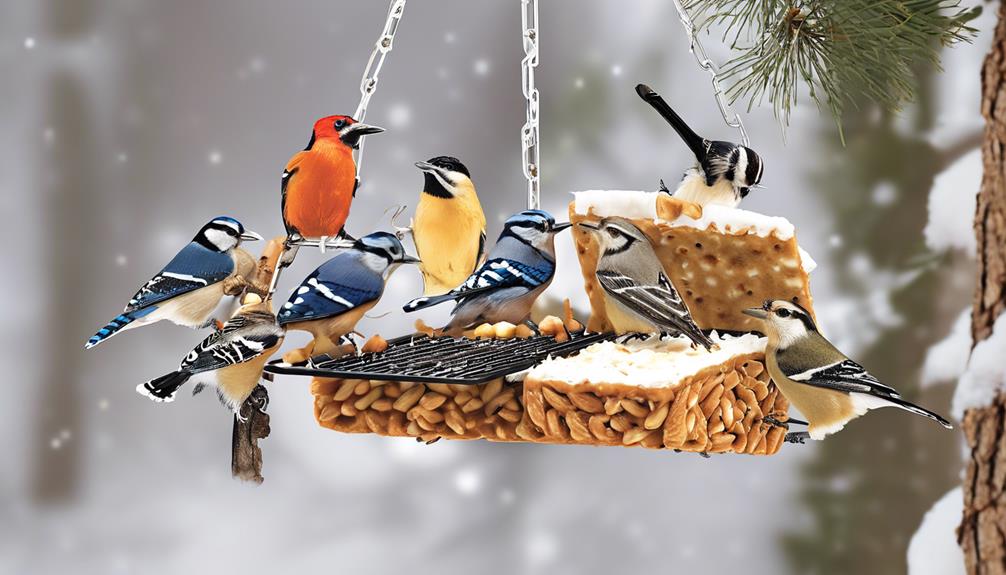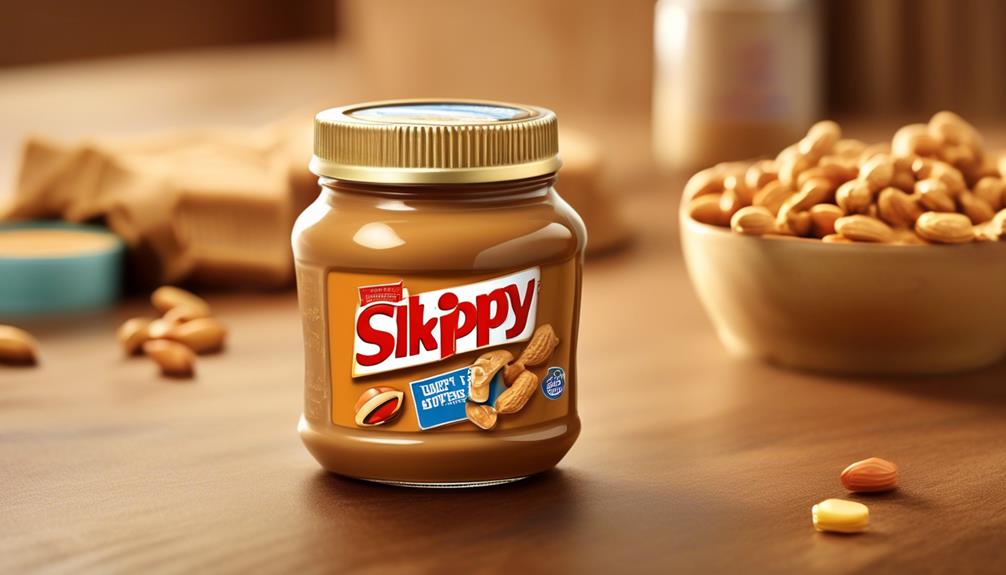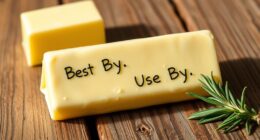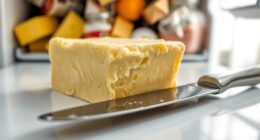We’ve all heard that peanut butter is an acquired taste, like the first sip of coffee or the initial bite of dark chocolate. But what if you want to join the peanut butter craze and just can’t seem to get there?
Well, fear not because there are some strategies that might just help you develop a liking for this creamy, nutty spread. From exploring different varieties to pairing it with complementary flavors, we've got some tips that might just turn you into a peanut butter aficionado.
Key Takeaways
- Incorporate small amounts of peanut butter gradually into your diet to overcome texture aversion.
- Opt for natural peanut butter to enjoy its nutritional benefits and avoid added oils and sugars.
- Experiment with different forms of peanut butter, such as in shakes or mixed with other ingredients, to find a preparation that suits your taste preferences.
- Pair peanut butter with complementary flavors like honey, bananas, dark chocolate, sliced apples, or cinnamon to enhance its taste and create delicious combinations.
Understanding the Nutritional Benefits
When it comes to choosing a healthier option, organic or natural peanut butter stands out due to its lack of additives and separation-preventing agents. If you're craving peanut butter, opting for the natural variety can be a nutritious choice. It's a great source of protein, with around 7-8 grams of protein per serving, depending on the brand. Protein is essential for building and repairing tissues, making it a valuable addition to your diet. Incorporating natural peanut butter into your meals can also help you lose weight, as the protein and healthy fats it contains can help you feel full and satisfied.
Not only does natural peanut butter offer a good dose of protein, but it also contains healthy fats that are beneficial for heart health. With no added salt and sugar, it provides a better flavor profile compared to conventional peanut butter. You can enjoy it on toast, with celery, in shakes, or even in baked goods.
Additionally, its natural taste can be complemented with alternative nut spreads like almond or cashew, enhancing the overall taste experience and supporting your well-being.
Exploring Different Peanut Butter Varieties

Exploring different peanut butter varieties allows for discovering a range of flavors and nutritional benefits, making it an exciting journey for those keen on expanding their culinary horizons. When craving peanut butter, it's essential to consider various options to find the perfect fit for your taste buds and health needs.
Here are some essential tips for exploring different peanut butter varieties:
- Opt for natural peanut butter to avoid added hydrogenated oils and refined sugars, making it a healthier and more functional food choice.
- Experiment with alternative nut spreads like almond or cashew butter for a different taste experience while still reaping the benefits of protein per serving.
- Combine peanut butter with dark chocolate for a delightful and decadent flavor pairing that introduces a new and enjoyable taste profile.
- Explore versatile uses of peanut butter, such as incorporating it into smoothies, oatmeal, sandwiches, and cooking, to discover its diverse culinary potential.
- Consider trying different preparations of peanut butter, such as in shakes, on toast, with celery, or in baked goods, to find creative and delicious ways to incorporate it into your diet.
Overcoming Texture Aversion

After exploring different peanut butter varieties and discovering a range of flavors and nutritional benefits, it's important to address overcoming texture aversion to fully enjoy this versatile food.
To start, incorporate small amounts of peanut butter into your diet gradually. This allows you to acclimate to its texture without feeling overwhelmed. Experiment with different forms of peanut butter, such as in shakes, baked goods, or mixed with other ingredients, to find a preparation that suits your taste preferences.
Pairing peanut butter with complementary textures can also help lessen the focus on its texture. Try adding it to crispy toast or crunchy fruits to balance out the consistency. Additionally, blending peanut butter into smooth textures like yogurt or a smoothie can minimize the perception of its texture.
Pairing Peanut Butter With Complementary Flavors

To enhance the enjoyment of peanut butter, consider pairing it with complementary flavors to create a delightful culinary experience. When combined with the right ingredients, peanut butter can transform into a delectable treat that satisfies your food cravings. Here are some complementary flavors that can help you add an exciting twist to your peanut butter creations:
- Honey: Drizzling a bit of honey over your peanut butter not only adds natural sweetness but also balances out the nutty flavor with a touch of floral sweetness.
- Bananas: Slicing fresh bananas and layering them on top of peanut butter creates a creamy, sweet, and savory combination that's both satisfying and nutritious.
- Dark Chocolate: Mixing peanut butter with dark chocolate creates a rich and indulgent flavor profile that's perfect for desserts or as a sweet snack.
- Apples: Pairing peanut butter with sliced apples adds a refreshing crunch and a subtle tartness that complements the creamy texture of the peanut butter.
- Cinnamon: Sprinkling a dash of cinnamon on peanut butter adds a warm and comforting flavor that enhances the overall taste experience.
These complementary flavors not only enhance the taste of peanut butter but also provide a variety of nutrients, making them an excellent choice for those seeking a balanced and flavorful snack.
Trying Small Peanut Butter Portions

When trying small portions of peanut butter, it's essential to taste different brands and types to find the one that suits your preferences.
Pairing the small portion with other familiar foods like apple slices or crackers can help ease into the flavor.
Tasting Different Brands
Upon sampling various peanut butter brands in small portions, we were able to discern distinct flavor profiles and textures among them. When tasting different brands, we found that:
- Natural peanut butter: Its rich, nutty flavor and slightly grainy texture appealed to our taste buds, offering a wholesome and authentic peanut taste.
- Taste a little: Sampling just a small amount allowed us to appreciate subtle nuances and differences in flavor intensity, saltiness, sweetness, and roasted notes.
- Spoonfuls of peanut butter: Taking small spoonfuls of peanut butter from each brand helped us compare the creaminess and thickness, ranging from silky smooth to more coarse textures.
- Brand-specific characteristics: Each brand exhibited unique qualities, such as a stronger roasted flavor, a hint of sweetness, or a saltier profile, catering to diverse preferences.
- Textural differences: The mouthfeel varied from creamy and spreadable to thicker and more densely textured, influencing overall enjoyment.
Exploring these nuances can help you find a peanut butter brand that suits your preferences.
Pairing With Other Foods
As we move forward in our exploration of peanut butter, we can expand our tasting experience by pairing small portions with other foods to gradually develop our palate for this versatile spread. Pairing peanut butter with complementary foods can help ease into its flavor and texture. Here's a practical way to approach this:
| Foods to Pair with Peanut Butter | Suggested Amount | Notes |
|---|---|---|
| Sliced Apples | Small spoonful | The sweetness of apples can balance the nuttiness of peanut butter. |
| Whole Grain Crackers | Small smear | The crunch of crackers adds a delightful texture to the creamy peanut butter. |
| Celery Sticks | Light spread | The refreshing crunch of celery provides a contrast to the rich taste of peanut butter. |
Pairing peanut butter with familiar and enjoyable foods like fruits, crackers, and vegetables can make the experience more enjoyable and help in acquiring a taste for peanut butter.
Experimenting With Peanut Butter Recipes

Let's explore some new flavor combinations and easy peanut butter recipes.
We can try adding peanut butter to smoothies, oatmeal, or even savory dishes for a unique twist.
Additionally, we can experiment with homemade peanut butter energy balls or cookies for a healthy and delicious treat.
New Flavor Combinations
Experimenting with peanut butter recipes can lead to discovering unique and delicious flavor combinations that enhance both the taste and health benefits of this versatile spread. When it comes to exploring new flavor combinations, consider the following:
- Incorporate natural peanut butter into recipes for a better taste and a healthier option.
- Try combining peanut butter with dark chocolate to create a delicious and healthier flavor combination.
- Explore alternative options such as almond or cashew spreads to find a spread that suits your taste preferences.
- Incorporate peanut butter into different meals and snacks to discover new and enjoyable flavor combinations.
- Experiment with adding peanut butter to different recipes like smoothies, baked goods, or savory dishes to develop a liking for it.
Easy Peanut Butter Recipes
Exploring easy peanut butter recipes allows us to discover delightful new flavors and textures while incorporating this versatile spread into our daily meals and snacks. Here are a few simple and delicious recipes to try:
| Recipe | Ingredients | Instructions |
|---|---|---|
| Peanut Butter Banana Smoothie | 1 ripe banana, 2 tbsp peanut butter, 1 cup almond milk, honey (optional) | Blend all ingredients until smooth and creamy. Enjoy! |
| Peanut Butter Energy Bites | 1 cup oats, 1/2 cup peanut butter, 1/3 cup honey, 1/2 cup mini chocolate chips, 1 tsp vanilla extract | Mix all ingredients together, roll into balls, and chill for 30 minutes. |
| Peanut Butter Apple Sandwich | 1 apple, cored and sliced, 2 tbsp peanut butter, granola | Spread peanut butter on apple slices, sprinkle with granola, and top with another apple slice. |
These recipes are easy to make and perfect for anyone looking to enjoy the goodness of peanut butter in different ways.
Mixing Peanut Butter Into Smoothies

Incorporating peanut butter into smoothies can enhance their creaminess and add a rich nutty flavor, elevating the overall taste and texture of the drink. Here are a few tips to make the most of adding peanut butter to your smoothies:
- Creaminess: Peanut butter's natural oils and smooth texture contribute to a luscious, creamy consistency in smoothies without the need for dairy or yogurt.
- Protein Boost: Peanut butter is a fantastic source of plant-based protein, making it an excellent addition for those looking to increase their protein intake.
- Flavor Enhancement: The nutty, slightly sweet taste of peanut butter can complement a variety of smoothie flavors, from chocolate and banana to berries and oats.
- Satiety: The healthy fats and protein in peanut butter can help keep you feeling full and satisfied, making your smoothie a more substantial snack or meal replacement.
- Texture: Blending peanut butter with fruits and vegetables adds a delightful thickness and body to your smoothie, making it more satisfying to drink.
Incorporating Peanut Butter Into Breakfast

Let's explore some delicious ways to incorporate peanut butter into our breakfast routine.
We can start by spreading it on toast, mixing it into oatmeal, or blending it into a smoothie for a satisfying and nutritious meal.
Additionally, we can experiment with pairing peanut butter with fruit, yogurt, or granola to create diverse and appealing breakfast options.
Breakfast Spread Options
Consider trying organic or natural peanut butter as a healthier and additive-free option for breakfast spreads, offering enhanced taste and nutritional benefits. When incorporating peanut butter into breakfast, it's essential to explore various options to find the best fit for your palate and health goals.
Here are some breakfast spread options to consider:
- Organic/Natural Peanut Butter: Free from additives and a healthier option due to its natural separation and nutritional benefits.
- Enhance Taste with Natural Peanut Butter: Use in shakes, toast, or baked goods for a better taste without added salt and sugar.
- Health Benefits of Avoiding Refined Sugars and Carbs: Opt for natural peanut butter over sugary breakfast spreads to support overall well-being.
- Pairing with Dark Chocolate: Combine natural peanut butter and dark chocolate for a delicious and healthier breakfast spread.
- Exploring Alternative Options: Try almond or cashew spreads and incorporate peanut butter into different breakfast preparations to develop a liking for it.
Peanut Butter Smoothie
We often start our mornings with a nutritious and delicious peanut butter smoothie, providing a satisfying and energy-boosting start to the day.
A peanut butter smoothie is an excellent way to incorporate this versatile ingredient into your breakfast routine. Not only does it add a rich and creamy texture, but it also offers a healthy dose of protein, fiber, and good fats.
To make a simple peanut butter smoothie, blend together a ripe banana, a scoop of natural peanut butter, Greek yogurt, a splash of almond milk, and a handful of spinach for an extra nutrient boost. You can also customize it with other ingredients like oats, honey, or cocoa powder.
This smoothie not only tastes delicious but also keeps you full and satisfied until your next meal.
Toast and Nut Butter
Incorporate a spread of peanut butter on whole grain toast for a nutritious and satisfying breakfast option that provides a balance of protein, healthy fats, and complex carbohydrates. This simple meal offers numerous benefits, including sustained energy levels, improved satiety, and essential nutrients.
When incorporating peanut butter into breakfast, consider these points:
- Protein Boost: Peanut butter is rich in protein, which supports muscle repair and growth.
- Healthy Fats: The monounsaturated and polyunsaturated fats in peanut butter contribute to heart health.
- Fiber Content: Whole grain toast provides fiber, promoting digestive health and aiding in weight management.
- Vitamins and Minerals: Peanut butter contains essential nutrients such as potassium, magnesium, and vitamin E.
- Versatility: Experiment with different nut butters, such as almond or cashew, for variety and diverse nutritional benefits.
Using Peanut Butter as a Dip

Peanut butter serves as a versatile and satisfying dip for a variety of snacks, including pretzels, carrots, and celery sticks, offering a quick and nutritious option for a snack. Here are some creative ways to enjoy using peanut butter as a dip:
| Snack | Peanut Butter Pairing |
|---|---|
| Pretzels | Creamy peanut butter |
| Carrots | Crunchy peanut butter |
| Celery sticks | Natural peanut butter |
Incorporate peanut butter into homemade granola bars or energy balls for a nutritious on-the-go option. Another delightful idea is to make a peanut butter and banana wrap by spreading peanut butter on a tortilla and adding sliced bananas before rolling it up. For those who enjoy smoothies, try creating a peanut butter and chocolate smoothie by blending peanut butter, cocoa powder, banana, milk, and ice. Alternatively, a peanut butter and jelly smoothie can be made by blending peanut butter, mixed berries, yogurt, and a splash of fruit juice. These simple yet delightful ideas are perfect for anyone looking to enhance their snacking experience using peanut butter as a dip.
Incorporating Peanut Butter Into Baked Goods

After enjoying peanut butter as a versatile dip for snacks, it's time to explore its potential in enhancing the flavor and texture of baked goods. Incorporating peanut butter into baked goods not only adds a delightful nutty taste but also brings a dose of nutrition to your treats. Here are some practical ways to incorporate peanut butter into your baking:
- Opt for natural peanut butter in baked goods for a healthier option without additives.
- Experiment with peanut butter in recipes such as cookies, brownies, and cakes to infuse a rich and indulgent flavor.
- Consider combining peanut butter with dark chocolate for a delicious and decadent twist in your baked goods.
- Try adding peanut butter to homemade granola bars or energy balls to create a nutritious on-the-go snack option that's both satisfying and filling.
- View peanut butter as a versatile ingredient that not only enhances the flavor but also boosts the nutritional value of your baked goods.
Incorporating peanut butter into baked goods opens up a world of delicious possibilities, offering a unique and delightful flavor profile while adding a nutritional boost.
Incorporating Peanut Butter Into Savory Dishes

When it comes to incorporating peanut butter into savory dishes, the possibilities are endless. We can use it to create a rich and flavorful peanut sauce for stir-fries, or as a base for a creamy and satisfying peanut soup.
Additionally, peanut butter can be a surprising and delicious addition to pasta dishes, adding a nutty depth of flavor that elevates the entire dish.
Peanut Butter in Pasta
Adding a spoonful of peanut butter to pasta sauce can create a creamy and nutty flavor, enhancing the overall taste of the dish. Here are a few ways to incorporate peanut butter into your pasta dishes:
- Create a Thai-inspired peanut sauce by combining peanut butter, soy sauce, and a dash of lime juice to toss with cooked pasta.
- Consider incorporating peanut butter into a spicy peanut noodle dish by blending it with chili paste, garlic, and sesame oil.
- Use peanut butter as a base for a savory satay sauce to drizzle over pasta dishes with grilled chicken or tofu.
- Try adding a dollop of peanut butter to a vegetable stir-fry for a unique and flavorful twist.
Peanut butter in pasta opens up a world of savory and delicious flavor combinations, adding a delightful richness to your meals.
Peanut Butter in Soup
Incorporating peanut butter into savory soups can add a delightful nutty creaminess and enhance the overall flavor profile of the dish. It brings a rich and unique taste that perfectly complements a variety of soup bases. Here's a practical way of incorporating peanut butter into soup:
| Peanut Butter in Soup | Description |
|---|---|
| African Peanut Soup | This traditional soup combines peanut butter with tomatoes, sweet potatoes, and a hint of spice for a hearty and satisfying meal. |
| Thai Peanut Curry Soup | A fusion of Thai flavors and creamy peanut butter creates a comforting and aromatic soup that is both sweet and savory. |
| Spicy Peanut and Pumpkin Soup | The combination of roasted pumpkin, spicy chili, and creamy peanut butter results in a warming and flavorful soup that is perfect for cooler days. |
These soups offer a delicious introduction to the concept of using peanut butter in savory dishes, and they are sure to delight the taste buds.
Peanut Butter in Stir-Fry
To elevate the flavor of stir-fry dishes, consider integrating peanut butter as a versatile and savory ingredient.
When incorporating peanut butter in stir-fry, it's essential to explore different options like organic or natural varieties to find one that suits your taste preferences.
Start by adding small amounts of peanut butter to stir-fry sauces or noodle dishes, gradually acquiring a taste for its savory richness.
Experiment with combining peanut butter with stir-fry vegetables, tofu, or chicken to create a flavorful and protein-packed meal.
Pairing peanut butter with savory ingredients such as soy sauce, garlic, ginger, and chili can help balance the flavors in stir-fry dishes.
As you become more accustomed to and appreciative of the taste, gradually increase the amount of peanut butter used in your savory recipes.
Trying Peanut Butter With Different Bread Types

How can we enhance the experience of eating peanut butter by experimenting with different types of bread? The right bread can truly elevate the taste and enjoyment of peanut butter.
When it comes to pairing peanut butter with bread, variety is the spice of life. Whole wheat, multigrain, and sourdough bread offer a hearty and wholesome base for the nutty spread. Consider toasting the bread beforehand to add a delightful warmth that enhances the flavor and texture of the peanut butter.
If you have a sweet tooth, opt for cinnamon raisin or honey wheat bread to complement the nutty taste of the spread. For a unique twist, explore using flatbreads, bagels, or even croissants to create diverse and interesting flavor combinations with peanut butter.
Don't be afraid to get creative and think outside the box – experiment with international bread options like naan, pita, or brioche to experience the delightful fusion of different cultural flavors with peanut butter.
Sampling Peanut Butter With Fruits and Vegetables

Exploring the diverse flavors of peanut butter with various bread types has been an enjoyable culinary adventure, and now we're eager to broaden our palate by sampling peanut butter with an array of fruits and vegetables.
Here are some tips for incorporating peanut butter into your fruit and vegetable snacks:
- Start with small portions of natural peanut butter and pair it with your favorite fruits like apples, bananas, or strawberries to ease into the taste.
- Try dipping celery sticks, carrot sticks, or cucumber slices into peanut butter as a savory option for sampling.
- Experiment with different textures and flavors by combining peanut butter with various fruits and vegetables to find a combination that suits your palate.
- Gradually increase the amount of peanut butter you consume with fruits and vegetables as you become more accustomed to the taste.
- Keep an open mind and be patient as your taste buds adjust to the flavor of peanut butter when paired with fruits and vegetables.
Sampling peanut butter with fruits and vegetables can introduce a whole new world of flavor combinations and provide a nutritious and satisfying snack option.
Discovering Peanut Butter Alternatives

Experimenting with different nut spreads like almond or cashew can provide flavorful alternatives to peanut butter. While peanut butter is a popular choice, exploring other options can open up new taste experiences. Here are some peanut butter alternatives to consider:
| Nut Spread | Flavor Profile | Uses |
|---|---|---|
| Almond Butter | Nutty and slightly | Smoothies, toast, fruit |
| sweet | dips, baked goods | |
| Cashew Butter | Creamy and mild | Sandwiches, stir-fries, |
| with a hint of | salad dressings | |
| natural sweetness |
These alternatives offer a range of flavors and textures that can complement various foods. They are also suitable for those following a low-fat diet, as they contain healthy fats that are beneficial for heart health. Additionally, incorporating these nut butters into your diet can provide essential nutrients such as protein, fiber, and essential vitamins and minerals. Experimenting with different nut spreads allows you to find the perfect alternative to peanut butter that suits your taste preferences and dietary needs.
Gradually Acquiring a Taste for Peanut Butter

Have you ever wondered how to develop a liking for peanut butter, even if you weren't a fan before? Gradually acquiring a taste for peanut butter is entirely possible. Here are some practical tips to help you ease into enjoying this popular spread:
- Start with Small Amounts: Begin by incorporating small amounts of peanut butter into your diet. This could be a thin layer on a piece of toast or a small dollop in a smoothie.
- Pair it with Complementary Flavors: Spread peanut butter on apple slices or celery sticks. The combination of flavors can help ease you into enjoying the taste of peanut butter.
- Experiment with Different Brands: Not all peanut butters are created equal. Try different brands and varieties to find one that suits your palate.
- Incorporate it into Recipes: Use peanut butter in cooking and baking to get accustomed to its taste in different contexts.
- Be Patient and Persistent: Acquiring a liking for peanut butter might take time, so be patient with yourself and keep experimenting with different ways of incorporating it into your diet.
Frequently Asked Questions
How Do You Eat Peanut Butter if You Don't Like It?
We eat peanut butter by trying different combinations like adding it to smoothies, oatmeal, or using it as a dip for fruits and veggies. Experimenting with various flavors and textures can help ease into liking it.
It's important to give it a few tries before forming a strong opinion. Gradually introducing it into your diet and exploring different brands can also make a difference in developing a taste for peanut butter.
Is It Normal to Not Like Peanut Butter?
Absolutely, not liking peanut butter is completely normal. Many people have a distaste for its taste, texture, or smell, and that's okay.
It's important to explore different nut spreads and combinations to find what works best for you. Understanding that not liking peanut butter is a personal preference can alleviate any feelings of pressure to enjoy it.
Exploring alternative options and being open to trying new combinations can help in developing a liking for peanut butter.
How Do You Eat Peanut Butter for Good Taste?
We've found that to enjoy peanut butter, experimenting with different pairings can make a big difference.
Try spreading it on apple slices, adding it to smoothies, or using it as a dip for celery or carrots.
Also, consider trying different types of peanut butter, like natural or flavored varieties, to see if any appeal to your taste buds.
What to Eat When You Crave Peanut Butter?
When we crave peanut butter, we can try natural or organic options for a healthier choice.
Experimenting with almond or cashew spreads provides tasty alternatives.
Combining peanut butter with dark chocolate offers a delicious and nutritious option.
Incorporating peanut butter into various meals and snacks, such as toast, smoothies, sandwiches, and baked goods, can help develop a liking for it.
These options allow us to enjoy the benefits of peanut butter in a variety of ways.
Conclusion
In conclusion, incorporating small portions of natural peanut butter into your meals and snacks can help you acquire a taste for it over time.
Don't be afraid to experiment with different varieties and pairings to find what works best for you.
Remember, Rome wasn't built in a day, and neither is a love for peanut butter.
So, take it one bite at a time and before you know it, you'll be spreading peanut butter on everything like it's nobody's business.
